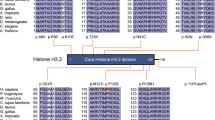Abstract
Human immunodeficiency virus type I enhancer binding protein 2 (HIVEP2) has been previously associated with intellectual disability and developmental delay in three patients. Here, we describe six patients with developmental delay, intellectual disability, and dysmorphic features with de novo likely gene-damaging variants in HIVEP2 identified by whole-exome sequencing (WES). HIVEP2 encodes a large transcription factor that regulates various neurodevelopmental pathways. Our findings provide further evidence that pathogenic variants in HIVEP2 lead to intellectual disabilities and developmental delay.


Similar content being viewed by others
References
Srivastava, S, Engels H, Schanze I, et al. (2016) Loss-of-function variants in HIVEP2 are a cause of intellectual disability. Eur J Hum Genet 24(4):556–561.
Rauch A, Wieczorek D, Graf E, et al. (2012) Range of genetic mutations associated with severe non-syndromic sporadic intellectual disability: an exome sequencing study. Lancet 380(9854):1674–1682
Tanaka AJ, Cho MT, Millan F, et al. (2015) Mutations in SPATA5 are associated with microcephaly, intellectual disability, seizures, and hearing loss. Am J Hum Genet 97(3):457–464
Sobreira N, Schiettecatte F, Valle D, Hamosh A (2015) GeneMatcher: a matching tool for connecting investigators with an interest in the same gene. Hum Mutat 36(10):928–930
Exome Aggregation Consortium (ExAC). Available from: http://exac.broadinstitute.org.
Petrovski S, Wang Q, Heinzen EL, et al. (2013) Genic intolerance to functional variation and the interpretation of personal genomes. PLoS Genet 9(8):e1003709
Choi Y, Chan AP (2015) PROVEAN web server: a tool to predict the functional effect of amino acid substitutions and indels. Bioinformatics 31(16):2745–2747
Kumar P, Henikoff S, Ng PC (2009) Predicting the effects of coding non-synonymous variants on protein function using the SIFT algorithm. Nat Protoc 4(7):1073–1081
Adzhubei IA, Schmidt S, Peshkin L, et al. (2010) A method and server for predicting damaging missense mutations. Nat Methods 7(4):248–249
Richards S, Aziz N, Bale S, et al. (2015) Standards and guidelines for the interpretation of sequence variants: a joint consensus recommendation of the American College of Medical Genetics and Genomics and the Association for Molecular Pathology. Genet Med 17(5):405–424
Firth HV, Richards SM, Bevan AP, et al. (2009) DECIPHER: Database of Chromosomal Imbalance and Phenotype in Humans Using Ensembl Resources. Am J Hum Genet 84(4):524–533
Sudo T, Ozawa K, Soeda EI, et al. (1992) Mapping of the human gene for the human immunodeficiency virus type 1 enhancer binding protein HIV-EP2 to chromosome 6q23-q24. Genomics 12(1):167–170
Wu LC (2002) ZAS: C2H2 zinc finger proteins involved in growth and development. Gene Expr 10(4):137–152
Dorflinger U, Pscherer A, Moser M, et al. (1999) Activation of somatostatin receptor II expression by transcription factors MIBP1 and SEF-2 in the murine brain. Mol Cell Biol 19(5):3736–3747
Fukuda S, Yamasaki Y, Iwaki T, et al. (2002) Characterization of the biological functions of a transcription factor, c-myc intron binding protein 1 (MIBP1). J Biochem 131(3):349–357
O’Neill LA, Kaltschmidt C (1997) NF-kappa B: a crucial transcription factor for glial and neuronal cell function. Trends Neurosci 20(6):252–258
Mattson MP (2005) NF-kappaB in the survival and plasticity of neurons. Neurochem Res 30(6–7):883–893
Takao K, Kobayashi K, Hagihara H, et al. (2013) Deficiency of schnurri-2, an MHC enhancer binding protein, induces mild chronic inflammation in the brain and confers molecular, neuronal, and behavioral phenotypes related to schizophrenia. Neuropsychopharmacology 38(8):1409–1425
Acknowledgments
We gratefully acknowledge the contribution of the patients and their families. This work is supported by a grant from the Simons Foundation.
Author information
Authors and Affiliations
Corresponding author
Ethics declarations
This study was approved by the Institutional Review Board of Columbia University. Informed consent was obtained from all individual participants included in the study. Additional informed consent was obtained from all individual participants for whom identifying information is included in this article.
Competing interests
Megan Cho, Kyle Retterer, Rick Person, Kristin Monaghan, and Lindsay Henderson are employees of GeneDx. Wendy Chung is a consultant at BioReference Laboratories.
Rights and permissions
About this article
Cite this article
Steinfeld, H., Cho, M.T., Retterer, K. et al. Mutations in HIVEP2 are associated with developmental delay, intellectual disability, and dysmorphic features. Neurogenetics 17, 159–164 (2016). https://doi.org/10.1007/s10048-016-0479-z
Received:
Accepted:
Published:
Issue Date:
DOI: https://doi.org/10.1007/s10048-016-0479-z




